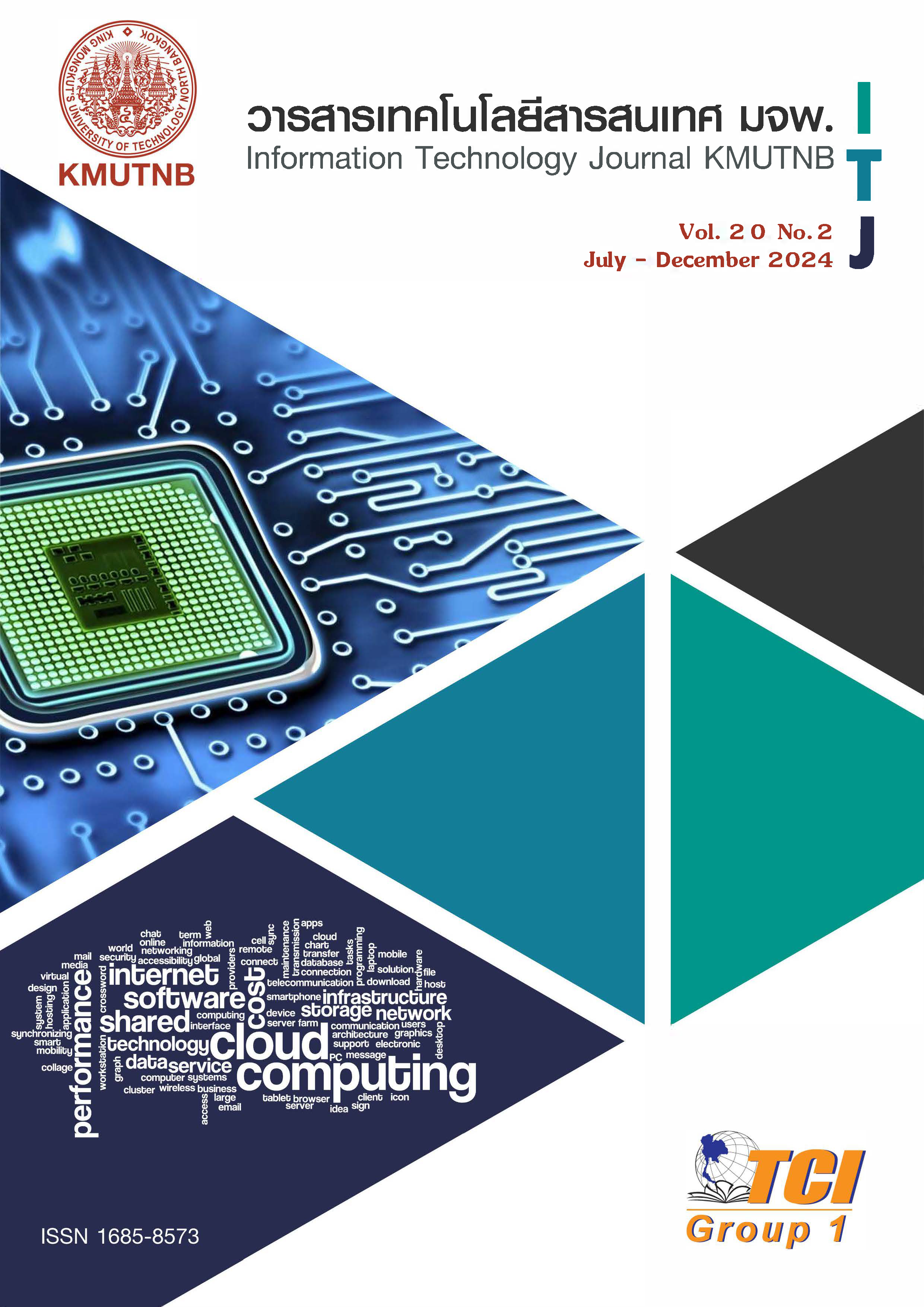Invention The Program of Hands Motion Detector for Translating Disabilities People's Sign Language
Main Article Content
Abstract
The number of people with disabilities is currently increasing, and in Thai society, the proportion of individuals with disabilities is notably high, approximately 3% of the population (Krungthep Turakij, 2022). Providing support and facilitating accessibility for people with disabilities is of great importance. As part of these efforts, we developed a motion detection program aimed at translating sign language for individuals with disabilities. This program utilizes object detection techniques, such as MediaPipe, in combination with machine learning. It accesses the camera to capture sign language gestures and compares them with models trained on a sign language gesture dataset. The program then displays the corresponding meaning on the screen, with the goal of aiding communication for people with disabilities. The results indicate that the model performs well when tested with a benchmark dataset of 75,000 sign language gestures. However, challenges arise when gestures are unclear, incorrect, not included in the dataset, or closely resemble other gestures, which may lead to misclassification. Additionally, limitations due to insufficiently powerful training equipment have caused a delay in processing and displaying gesture meanings, with a lag time of approximately 5-10 seconds. Despite these challenges, the model achieves an accuracy of 76.40%, which is considered satisfactory. The program is also capable of translating the detected gestures into the Thai language.
Article Details
References
Bangkokbiznew, Thailand. Available Online at https://www.bangkokbiznews.com/corporate-moves/lifestyle/judprakai/1041542, accessed on 27 April 2024.
S. Naqvi, J. Ohene-Djan, and R. Spiegel. "Testing the effectiveness of digital representations of sign language content." the Instructional Technology and Education of the Deaf Symposium Rochester, New York, 2005.
J. Whitehill. Automatic Real-time Facial Expression Recognition for Signed Language Translation. Master’s thesis. University of the Western Cape. Computer Science, 2006.
V. M. Segers. "The efficacy of the eigenvector approach to south african sign language identification." In South African Telecommunication Networks and Applications Conference 2009, pp. 363-366, 2009.
P. Li. Hand shape estimation for South African Sign Language. Master's thesis University of the Western Cape Computer Science, 2010.
C. Rajah. Chereme-based recognition of isolated, dynamic gestures from South African Sign Language with Hidden Markov Models. Master's thesis University of the Western Cape Computer Science, 2006.
C.-S. Lee, Z. Bien, G. T. Park, W. Jang, J. S. Kim, and S. K. Kim. "Real-Time recognition system of Korean sign language based on elementary components." In Proceedings of the 6th IEEE International Conference on Fuzzy Systems 1997, pp. 1463-1468, 1997.
Y. H. Lee and C. Y. Tssai. "Taiwan sign language (TSL) recognition based on 3D data and neural networks." Expert Systems with Applications, Vol. 36, No. 2, pp. 1123-1128, 2007.
N. D. Sandhya and K. R. Charanjeet. "A review on Machine Learning Techniques." International Journal on Recent and Innovation Trends in Computing and Communication (IJRITCC), Vol. 4, No. 3, pp. 395-399, 2019.
D. M. Kishore, S. Bindu, and N. K. Manjunath. "Estimation of yoga postures using machine learning techniques." International Journal of Yoga, Vol. 15, No. 2, pp. 137-143, May-August, 2022.
Y. Quiñonez, C. Lizarraga, and R. Aguayo. "Machine Learning solutions with MediaPipe." 2022 11th International Conference On Software Process Improvement (CIMPS), pp. 212-215, 2022.
MediaPipe Pose. Available online: https://google. github.io/mediapipe/solutions/pose.html, accessed on 28 December 2023.
M. Nour, M. Gardoni, J. Renaud, and S. Gauthier. "Real-time detection and motivation of eating activity in elderly people with dementia using pose estimation with TensorFlow and OpenCV." Advances in Social Sciences Research Journal, Vol. 8, No. 3, pp. 28-34, 2021.
G. Bradski and A. Kaehler. Learning OpenCV: Computer vision with the OpenCV library. O'Reilly Media, Inc. 2008.
OpenCV Open Source Computer Vision library. Available Online at http://opencv.willowgarage. com/wiki/ accessed on 27 April 2024.
M. Ashraf, S. M. Ahmad, N. A. Ganai, R.A. Shah, M. Zaman, S. A. Khan, and A. Shah. "Prediction of cardiovascular disease through cutting-edge deep learning technologies: an empirical study based on TENSOR FLOW, PYTORCH and KERAS." In International Conference on Innovative Computing and Communications. Proceedings of ICICC Springer Singapore 2020, Vol. 1, pp. 239-255, 2020.
S. W. B. Tan, P. K. Naraharisetti, S. K. Chin, and L. Y. Lee. "Simple Visual-Aided Automated Titration Using the Python Programming Language." Journal of Chemical Education, Vol. 97, pp. 850-854, 2020.
D. Ulus, V. Kraevo, and A. Sheffer. "D-Charts: Quasi-Developable Mesh Segmentation, Computer Graphics." Eurographics 2005, Vol. 24, No. 3, pp. 981-990, 2005.
A. Sheffer, B. Levy, M. Mogilnitsk, and A. Bogomyakov. "ABF++: Fast and Robust Angle Based Flattening." ACM Transactions on Graphics, Vol. 24, No. 2, pp. 311-330, 2005.
C. Damrongekarun1, L. Pisitpipattana1, S. Waijanya1, and N. Promrit. "Development of Thai Sign Language Detection and Conversion System into Thai with Deep Learning." KKU Science Journal, Vol. 51, No. 3, pp. 216-225, 2023.
X. Shi, Z. Chen, H. Wang, and D. Y. Yeung. "Convolutional LSTM network: a machine learning approach for precipitation nowcasting." Advances in Neural Information Processing Systems 28 (NIPS 2015), 2015.
S. Kim, S. Hong, M. Joh, and S. Song. "Deep Rain: ConvLSTM network for precipitation prediction using multichannel radar data." 7th International Workshop On Climate Informatics, pp. 20-22, September, 2017.
N. K. Mai, D. Yang, I. Shin, H. Kim, and M. Hwang. "Dprelu: Dynamic parametric rectified linear unit." The 9th International Conference on Smart Media and Applications, pp. 121-125, 2020.
A. Kumar and A. Abraham. "Opinion Mining to Assist User Acceptance Testing for Open-Beta Versions." Journal of Information Assurance and Security, Vol. 12, No. 4, pp. 146-153, 2017.
Tecperson, Sign Language MNIST. Available Online at https://www.kaggle.com/datasets/datamunge/sign-language-mnist, accessed on 27 April 2024.


